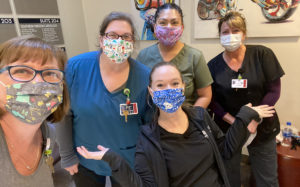Share:
STAT: Double occupancy rooms
If you have questions about double-occupancy rooms, we’ve got answers.
Do you have questions about double-occupancy rooms? Let me and my friends in Infection Prevention answer them for you.
There are some decision points to determine if a patient is appropriate for a double-occupancy room. Let’s ask a few questions and go through an algorithm to decide what’s best for your patients.
- Is the patient a person under monitoring, a person under investigation, in a rule-out status for COVID-19 or do they have respiratory symptoms of unknown cause?
- If you answer YES, they are NOT eligible for double-occupancy placement.
- Does the patient require isolation precautions or have an infection flag present in the chart?
- If YES, they can be placed in a room with a patient with the same confirmed positive organism.
- If YES, consult Infection Prevention prior to patient placement.
- If NO, the patient is not appropriate for a double-occupancy room.
- If both questions can be answered NO, the patient may be appropriate for a double-occupancy room at this time. Talk to your charge nurse who will have additional assessment points that may deem the patient inappropriate for a double-occupancy room.
OR
- Is the patient currently symptomatic from and has a known, confirmed diagnosis of COVID-19 (i.e., symptomatic with positive SARS-CoV-2 PCR test, and has not yet met criteria for recovery/release from isolation)?
- If YES, patient may be eligible for double-occupancy room placement ONLY with another patient confirmed to have COVID-19 on a designated unit; consult Infection Prevention prior to patient placement.
- Talk with your charge nurse and work together to ask these questions: Will the patient require aerosol generating procedure? If YES, the patient is not appropriate for double occupancy.
- Does the patient have a condition or circumstance that would prevent them from being able to safely and reliably wear a cloth mask (e.g., under 2 years of age, unable to understand or follow instructions, or is unable to remove a mask on their own if necessary)? If YES, the patient is not appropriate for double occupancy.
- If either of these questions you answered YES, proceed with moving the patient to a private room.
Here are some double-occupancy room guidelines to remember:
- When the patient is out of bed, they are required to wear their mask.
- Ensure beds and patient care spaces are at least six feet apart to maintain physical distancing.
- The number of visitors, staff, health care workers in the room at one time should never exceed 10 (including the patients). In most cases the number should be significantly fewer, as each person must stay six feet apart.
- If a visitor or health care worker is in the room, they are required to wear a mask for the duration of their visit.
- Patient curtains should always be kept drawn between patients to help provide a barrier between them, and maintain physical distance requirements. They must be replaced per protocol/policy.
- If a patient who is in a double-occupancy room is found to have an infection or is in a rule-out state for an infection that requires transmission-based precautions, the curtain needs to be changed once the patient is transferred to a private room.
- Patient equipment should be dedicated to a single patient whenever possible (vitals machine, interpreter phone, etc.).
- Any shared equipment must be cleaned before and after each use.
- Actively assess and eliminate clutter within the room; store patient’s personal belongings in designated cabinets.
- Increase frequency of cleaning; bedside staff are expected to wipe down high touch communal surfaces multiple times daily (doorknobs, light switches, etc.), at minimum, once per shift.
- Consult with Environmental Services regarding increasing frequency of daily cleaning and disinfection of shared bathroom with terminal disinfection agents (i.e., bleach).
Let’s review patients with aerosol generating procedures or devices and who should NOT be sharing a room with anyone:
- Medication administration via continuous nebulizer
- Induction of sputum
- High-flow nasal oxygen (e.g., nasal cannula flow rates > 6 lpm; heated high flow nasal cannulas)
- Non-invasive ventilation (NIV) such as bi-level positive airway pressure (BiPAP) and continuous positive airway pressure ventilation (CPAP)
- High frequency oscillating ventilation (HFOV)
- Intubation, extubation, and related procedures such as manual ventilation and open suctioning
- Tracheotomy/tracheostomy care (insertion/suctioning/removal)
- Volume diffusive respirator (VDR) ventilation
- Intrapulmonary percussive ventilation (IPV)
- Bronchoscopy
- Tracheotomy/tracheostomy procedures (insertion/open suctioning/removal)
Please email As***********************@as****.org” target=”_blank” rel=”noopener noreferrer”>Asante Infection Prevention or Doc Halo if you have any questions.
If you have a question, please contact the author or relevant department directly.




2 Comments. Leave new
I’m glad I don’t have to make these decisions. I was baffled on the second bullet point section, third sub bullet point “No”…And then it only got more confusing from there 😖
Dr Gross
Dr. Gross, that bullet point is confusing to me as well.